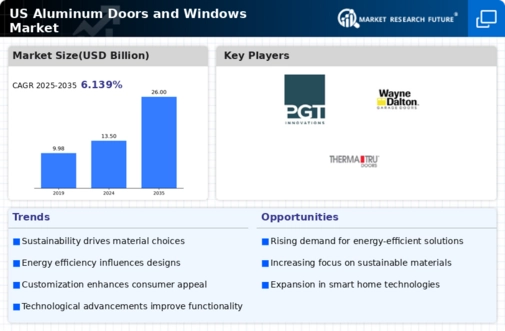Rising Demand for Energy Efficiency
The aluminum doors and windows market is experiencing a notable increase in demand for energy-efficient products. As consumers become more environmentally conscious, they seek solutions that reduce energy consumption. Aluminum doors and windows, known for their thermal performance, are increasingly favored for residential and commercial applications. According to recent data, energy-efficient windows can reduce heating and cooling costs by up to 30%. This trend is further supported by government incentives promoting energy-efficient home improvements, which are likely to drive sales in the aluminum doors-and-window market. The emphasis on sustainability and energy savings is reshaping consumer preferences, making energy-efficient aluminum products a key driver in the market.
Aesthetic Versatility and Design Trends
Aesthetic versatility is emerging as a crucial driver in the aluminum doors-and-window market. With a growing emphasis on architectural design, consumers are increasingly drawn to products that offer both functionality and visual appeal. Aluminum doors and windows can be customized in various colors, finishes, and styles, catering to diverse consumer preferences. This adaptability allows architects and designers to incorporate aluminum products into a wide range of building designs, from modern to traditional. As the trend towards personalized and unique home designs continues, the demand for aesthetically pleasing aluminum solutions is expected to grow, further propelling the market forward.
Regulatory Standards and Building Codes
The aluminum doors and windows market is significantly influenced by evolving regulatory standards and building codes. Stricter regulations regarding energy efficiency and safety are compelling manufacturers to innovate and improve their product offerings. For instance, the International Energy Conservation Code (IECC) mandates specific performance criteria for windows, which has led to an increased focus on high-performance aluminum products. Compliance with these standards not only enhances product appeal but also ensures market access. As builders and architects prioritize compliance with these regulations, the demand for aluminum doors and windows that meet or exceed these standards is likely to rise, thereby driving market growth.
Technological Advancements in Manufacturing
Technological advancements in manufacturing processes are playing a pivotal role in shaping the aluminum doors-and-window market. Innovations such as automated production lines and advanced coating techniques enhance product quality and reduce production costs. These improvements enable manufacturers to offer high-performance aluminum doors and windows at competitive prices. Moreover, the integration of smart technologies, such as automated locking systems and energy monitoring, is becoming increasingly prevalent. As consumers seek modern solutions that enhance convenience and security, the demand for technologically advanced aluminum products is likely to rise. This trend not only boosts market competitiveness but also aligns with consumer expectations for innovation in the aluminum doors-and-window market.
Urbanization and Infrastructure Development
Urbanization continues to be a significant driver for the aluminum doors-and-window market. As more people migrate to urban areas, the demand for residential and commercial buildings rises. This trend necessitates the use of durable and aesthetically pleasing materials, such as aluminum, which offers both functionality and design flexibility. The construction sector in the US is projected to grow at a CAGR of 4.5% over the next five years, further boosting the demand for aluminum doors and windows. Additionally, infrastructure development projects, including schools, hospitals, and commercial spaces, are increasingly incorporating aluminum products due to their lightweight nature and resistance to corrosion, thereby enhancing the market's growth potential.














Leave a Comment